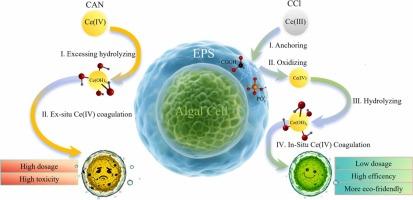Anchored adsorption and in-situ coagulation of cyanobacteria via Ce(III)-based salt: Enhanced removal efficiency and reduced toxicity
IF 11.3
1区 环境科学与生态学
Q1 ENGINEERING, ENVIRONMENTAL
引用次数: 0
Abstract
This study compared the coagulation performance, floc characteristics, and algal cell integrity between cerium-based coagulants and polyaluminum chloride (PAC). Under optimal dosage (6 mg Ce/L), both CAN (Ce(IV)-based) and CCl (Ce(III)-based) exhibited comparable algal removal efficiency to PAC (>90%), while generating larger flocs (>1200 µm) that settled rapidly (90% within 5 min). However, CAN caused significant algal cell lysis during floc aging, whereas CCl exhibited minimal cell damage. Analysis of CCl flocs revealed a distinct increase in the Ce(IV) concentration post-coagulation, accompanied by pronounced phosphate and carboxyl peaks on the floc surface. Further investigation into the extracellular polymeric substances (EPS) during algal coagulation proved that the coagulation mechanism of CCl proceeded in two steps: 1) Anchoring of the coagulant onto the algal surface via strong adsorption of phosphate and carboxyl groups; 2) Synergistic interactions between algae and EPS, which induced partial oxidation of Ce(III) to Ce(IV), triggering in-situ hydrolysis of Ce(IV). This process generated large floc structures and the subsequent coagulation targeted to algae. This study highlights CCl as an eco-friendly and effective alternative with high algal removal and low toxicity (attributed to reduced Ce(IV) dosage), offering practical advantages for water treatment applications.

通过Ce(III)基盐锚定吸附和原位混凝蓝藻:提高去除效率和降低毒性
本研究比较了铈基混凝剂和聚合氯化铝(PAC)的混凝性能、絮凝特性和藻类细胞完整性。在最佳投加量(6 mg Ce/L)下,CAN (Ce(IV)基)和CCl (Ce(III)基)的除藻效率与PAC相当(>90%),同时产生较大的絮凝体(>1200µm),沉降速度快(5 min内90%)。然而,CAN在絮凝老化过程中引起显著的藻细胞裂解,而CCl则表现出最小的细胞损伤。对CCl絮凝体的分析显示,絮凝后Ce(IV)浓度明显升高,并在絮凝体表面出现明显的磷酸和羧基峰。通过对藻絮凝过程中胞外聚合物质(EPS)的进一步研究,证明CCl的絮凝机制分为两个步骤:1)通过对磷酸盐和羧基的强吸附将絮凝剂锚定在藻表面;2)藻类与EPS协同作用,诱导Ce(III)部分氧化为Ce(IV),引发Ce(IV)的原位水解。这个过程产生了大的絮凝体结构,随后的絮凝针对藻类。本研究强调了CCl作为一种生态友好且有效的替代品,具有高藻类去除率和低毒性(由于减少了Ce(IV)的剂量),为水处理应用提供了实际优势。
本文章由计算机程序翻译,如有差异,请以英文原文为准。
求助全文
约1分钟内获得全文
求助全文
来源期刊

Journal of Hazardous Materials
工程技术-工程:环境
CiteScore
25.40
自引率
5.90%
发文量
3059
审稿时长
58 days
期刊介绍:
The Journal of Hazardous Materials serves as a global platform for promoting cutting-edge research in the field of Environmental Science and Engineering. Our publication features a wide range of articles, including full-length research papers, review articles, and perspectives, with the aim of enhancing our understanding of the dangers and risks associated with various materials concerning public health and the environment. It is important to note that the term "environmental contaminants" refers specifically to substances that pose hazardous effects through contamination, while excluding those that do not have such impacts on the environment or human health. Moreover, we emphasize the distinction between wastes and hazardous materials in order to provide further clarity on the scope of the journal. We have a keen interest in exploring specific compounds and microbial agents that have adverse effects on the environment.
 求助内容:
求助内容: 应助结果提醒方式:
应助结果提醒方式:


